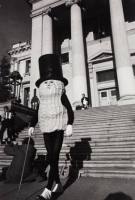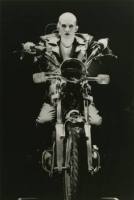Image Bank - Ausstellung Berlin

Ausstellung Institution KW Institute for Contemporary Art
Datum: 22.06.2019 - 01.09.2019
Künstler: Image Bank
Veranstalter & Ort:
Institution KW Institute for Contemporary Art
10117 Berlin
Auguststraße 69
***Please scroll down for English version***
Image Bank wurde 1970 von Michael Morris (geboren 1946 in Saltdean, GB), Vincent Trasov (geboren 1947 in Edmonton, CA) und Gary Lee-Nova (geboren 1943 in Toronto, CA) in Vancouver (CA) ins Leben gerufen. Als Modell für ein utopisch-alternatives Distributionssystem für Kunst außerhalb des institutionellen Radars von Museum und Markt initiierte Image Bank von Vancouver aus einen elf Jahre währenden, internationalen Austausch von Bildern und Korrespondenzen auf postalischem Weg, oft mit fließenden Grenzen zur konkreten Poesie. Zu den regelmäßigen Kollaborateur*innen des stetig wachsenden Netzwerks zählten neben Morris, Trasov und Lee-Nova u.a. Dana Atchley, Robert Cumming, Dick Higgins, Geoff Hendricks, Glenn Lewis, Eric Metcalfe, Kate Craig, Willoughby Sharp, General Idea und Ant Farm. Image Bank stand in engem Austausch mit anderen Mail Art-Kollektiven wie Ray Johnsons New York Correspondence School oder Robert Filliou und seiner Eternal Network-Idee. Die Appropriation und Umschreibung von Bild- und Sprachproduktionen aus Mainstream-Medien und oft wechselnde, Duchamp’sche, genderübergreifende Pseudonyme, die beteiligte Künstler*innen zirkulieren ließen, waren subversive Äußerungen zu Nachkriegs-Individualismus und -Konsumkultur und partizipierten an einem Moment beschleunigten Informations- und Datenaustauschs. Sie validierten zugleich die mythologisch-libidinale Kraft banalster, massenweise distribuierter Bildwelten und Wortspiele. Das Interesse an der Idee des Fetischs, das Image Bank mit General Idea in Toronto teilte, sowie am Ritual und Archiv, bestimmte die mannigfachen Tätigkeiten des Netzwerks bis zu seiner Umbenennung in Trasov/Morris-Archiv im Jahr 1977 aufgrund eines Copyright-Streits.
Das Archiv umfasst mehr als 10.000 Ephemera (Korrespondenzen, Postkarten, Briefpapier, Zeichnungen, Notizen, Collagen und Konzeptpapieren) sowie Fotografien, Filme und Requisiten. Die KW Institute for Contemporary Art präsentieren in Kooperation mit der Morris and Helen Belkin Art Gallery (Vancouver, CA) die weltweit umfassendste Retrospektive von Image Bank und geben einen Überblick über ihre wichtigsten Projekte, die aus einem Moment kollaborativer Kunstproduktion hervorgegangen sind, die die Grenze zwischen Kunst und Leben von Grund auf in Frage stellte und zeitgenössische Fragen zu Netzwerken, Tagging/Keyword-Indexing, kollektiver Autor*innenschaft und UGC (User Generated Content) vorwegnahm. Die Ausstellung wird im Sommer 2020 in der Morris and Helen Belkin Art Gallery an der University of British Columbia zu sehen sein.
Zur Ausstellung erscheint ein Katalog mit Texten, u.a. von AA Bronson, Zanna Gilbert, Krist Gruijthuijsen, Angie Keefer, Maxine Kopsa, Hadrien Laroche, Felicity Tayler and Scott Watson.
Kurator*innen: Krist Gruijthuijsen, Maxine Kopsa, Scott Watson
Assistenzkuratorin: Kathrin Bentele
Die Ausstellung wird großzügig unterstützt vom Canada Council for the Arts, der Audain Foundation und der Botschaft von Kanada.
***English***
Image Bank was founded in 1970 in Vancouver, Canada, by artists Michael Morris (born 1946 in Saltdean, GB), Vincent Trasov (born 1947 in Edmonton, CA) and Gary Lee-Nova (born 1943 in Toronto, CA). A model for a utopian, alternative system of art distribution operating outside institutions like the museum and the market, Image Bank engaged in an international exchange of images and correspondence by mail. Among the artists participating in the ever-growing network of exchange were (besides Morris, Trasov, and Lee-Nova) Dana Atchley, Robert Cumming, Dick Higgins, Geoff Hendricks, Glenn Lewis, Eric Metcalfe, Kate Craig, Willoughby Sharp, General Idea and Ant Farm. Image Bank maintained close ties with Ray Johnson’s New York Correspondence School as well as Robert Filliou and his concept of the Eternal Network. Using frequently changing Duchampian, gender-crossing aliases, and appropriating and reworking images and texts from mainstream media was both a subversive take on post-war individualism and consumer culture, and a way of partaking in an accelerated flow of data. At the same time, Image Bank’s production affirmed the mythological and libidinous power of mass distributed visual imagery and puns. Its interest in the idea of the fetish—which it shared with General Idea in Toronto—in rituals, and in archives shaped the collective’s manifold activities until 1978, when, due to a copyright challenge, it was renamed the Morris/Trasov Archive.
The archive is comprised of more than 10,000 files of ephemera (correspondence, postcards, stationery, notes, collages, and concept drafts) as well as photography, film and props. In collaboration with the Morris and Helen Belkin Art Gallery at the University of British Columbia (Vancouver, CA), KW Institute for Contemporary Art presents the most comprehensive retrospective of Image Bank to date. The exhibition gives an overview of the collective’s most important projects emerging from a moment of collaborative production that fundamentally questioned the boundary between art and life and anticipated topics relevant today, such as networks, tagging/keyword indexing, collective authorship, and UGC (user generated content). The exhibition will travel to the Morris and Helen Belkin Art Gallery at the University of British Columbia in Summer 2020.
A catalogue will accompany the exhibition, featuring texts by AA Bronson, Zanna Gilbert, Krist Gruijthuijsen, Angie Keefer, Maxine Kopsa, Hadrien Laroche, Felicity Tayler and Scott Watson.
Curators: Krist Gruijthuijsen, Maxine Kopsa, Scott Watson
Assistant Curator: Kathrin Bentele
The exhibition is generously supported by the Canada Council for the Arts, the Audain Foundation and the Embassy of Canada in Berlin.
Image Bank wurde 1970 von Michael Morris (geboren 1946 in Saltdean, GB), Vincent Trasov (geboren 1947 in Edmonton, CA) und Gary Lee-Nova (geboren 1943 in Toronto, CA) in Vancouver (CA) ins Leben gerufen. Als Modell für ein utopisch-alternatives Distributionssystem für Kunst außerhalb des institutionellen Radars von Museum und Markt initiierte Image Bank von Vancouver aus einen elf Jahre währenden, internationalen Austausch von Bildern und Korrespondenzen auf postalischem Weg, oft mit fließenden Grenzen zur konkreten Poesie. Zu den regelmäßigen Kollaborateur*innen des stetig wachsenden Netzwerks zählten neben Morris, Trasov und Lee-Nova u.a. Dana Atchley, Robert Cumming, Dick Higgins, Geoff Hendricks, Glenn Lewis, Eric Metcalfe, Kate Craig, Willoughby Sharp, General Idea und Ant Farm. Image Bank stand in engem Austausch mit anderen Mail Art-Kollektiven wie Ray Johnsons New York Correspondence School oder Robert Filliou und seiner Eternal Network-Idee. Die Appropriation und Umschreibung von Bild- und Sprachproduktionen aus Mainstream-Medien und oft wechselnde, Duchamp’sche, genderübergreifende Pseudonyme, die beteiligte Künstler*innen zirkulieren ließen, waren subversive Äußerungen zu Nachkriegs-Individualismus und -Konsumkultur und partizipierten an einem Moment beschleunigten Informations- und Datenaustauschs. Sie validierten zugleich die mythologisch-libidinale Kraft banalster, massenweise distribuierter Bildwelten und Wortspiele. Das Interesse an der Idee des Fetischs, das Image Bank mit General Idea in Toronto teilte, sowie am Ritual und Archiv, bestimmte die mannigfachen Tätigkeiten des Netzwerks bis zu seiner Umbenennung in Trasov/Morris-Archiv im Jahr 1977 aufgrund eines Copyright-Streits.
Das Archiv umfasst mehr als 10.000 Ephemera (Korrespondenzen, Postkarten, Briefpapier, Zeichnungen, Notizen, Collagen und Konzeptpapieren) sowie Fotografien, Filme und Requisiten. Die KW Institute for Contemporary Art präsentieren in Kooperation mit der Morris and Helen Belkin Art Gallery (Vancouver, CA) die weltweit umfassendste Retrospektive von Image Bank und geben einen Überblick über ihre wichtigsten Projekte, die aus einem Moment kollaborativer Kunstproduktion hervorgegangen sind, die die Grenze zwischen Kunst und Leben von Grund auf in Frage stellte und zeitgenössische Fragen zu Netzwerken, Tagging/Keyword-Indexing, kollektiver Autor*innenschaft und UGC (User Generated Content) vorwegnahm. Die Ausstellung wird im Sommer 2020 in der Morris and Helen Belkin Art Gallery an der University of British Columbia zu sehen sein.
Zur Ausstellung erscheint ein Katalog mit Texten, u.a. von AA Bronson, Zanna Gilbert, Krist Gruijthuijsen, Angie Keefer, Maxine Kopsa, Hadrien Laroche, Felicity Tayler and Scott Watson.
Kurator*innen: Krist Gruijthuijsen, Maxine Kopsa, Scott Watson
Assistenzkuratorin: Kathrin Bentele
Die Ausstellung wird großzügig unterstützt vom Canada Council for the Arts, der Audain Foundation und der Botschaft von Kanada.
***English***
Image Bank was founded in 1970 in Vancouver, Canada, by artists Michael Morris (born 1946 in Saltdean, GB), Vincent Trasov (born 1947 in Edmonton, CA) and Gary Lee-Nova (born 1943 in Toronto, CA). A model for a utopian, alternative system of art distribution operating outside institutions like the museum and the market, Image Bank engaged in an international exchange of images and correspondence by mail. Among the artists participating in the ever-growing network of exchange were (besides Morris, Trasov, and Lee-Nova) Dana Atchley, Robert Cumming, Dick Higgins, Geoff Hendricks, Glenn Lewis, Eric Metcalfe, Kate Craig, Willoughby Sharp, General Idea and Ant Farm. Image Bank maintained close ties with Ray Johnson’s New York Correspondence School as well as Robert Filliou and his concept of the Eternal Network. Using frequently changing Duchampian, gender-crossing aliases, and appropriating and reworking images and texts from mainstream media was both a subversive take on post-war individualism and consumer culture, and a way of partaking in an accelerated flow of data. At the same time, Image Bank’s production affirmed the mythological and libidinous power of mass distributed visual imagery and puns. Its interest in the idea of the fetish—which it shared with General Idea in Toronto—in rituals, and in archives shaped the collective’s manifold activities until 1978, when, due to a copyright challenge, it was renamed the Morris/Trasov Archive.
The archive is comprised of more than 10,000 files of ephemera (correspondence, postcards, stationery, notes, collages, and concept drafts) as well as photography, film and props. In collaboration with the Morris and Helen Belkin Art Gallery at the University of British Columbia (Vancouver, CA), KW Institute for Contemporary Art presents the most comprehensive retrospective of Image Bank to date. The exhibition gives an overview of the collective’s most important projects emerging from a moment of collaborative production that fundamentally questioned the boundary between art and life and anticipated topics relevant today, such as networks, tagging/keyword indexing, collective authorship, and UGC (user generated content). The exhibition will travel to the Morris and Helen Belkin Art Gallery at the University of British Columbia in Summer 2020.
A catalogue will accompany the exhibition, featuring texts by AA Bronson, Zanna Gilbert, Krist Gruijthuijsen, Angie Keefer, Maxine Kopsa, Hadrien Laroche, Felicity Tayler and Scott Watson.
Curators: Krist Gruijthuijsen, Maxine Kopsa, Scott Watson
Assistant Curator: Kathrin Bentele
The exhibition is generously supported by the Canada Council for the Arts, the Audain Foundation and the Embassy of Canada in Berlin.
Ads
weitere Ausstellungen von KW Institute for Contemporary Art

30.05.2020 - 19.07.2020
Hassan Sharif: I Am The Single Work Artist

30.05.2020 - 19.07.2020
Mophradat’s Consortium Commissions: Jasmina Metwaly & Yazan Khalili

28.02.2020 - 14.03.2020
I Am The Single Artist

22.06.2019 - 01.09.2019
Heike-Karin Föll: speed

22.06.2019 - 01.09.2019
Image Bank

07.06.2019 - 18.08.2019
Kunstpreis der Schering Stiftung 2018: Anna Daučíková

09.02.2019 - 05.05.2019
David Wojnarowicz Photography & Film 1978–1992

09.02.2019 - 05.05.2019
Reza Abdoh